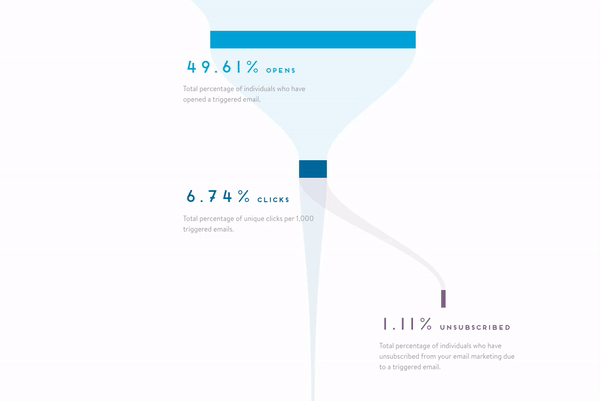
How to Benchmark Triggered Email Performance
Introducing an interactive calculator for customized triggered email benchmarks
How am I doing? It’s a universal question that’s taken on a whole new meaning for marketers thanks to the rise of analytics.
On the one hand, it’s easier than ever to measure performance of different activities and track improvements on key metrics over time. On the other hand, how do you know if what you’re doing is any good compared to everyone else? For example, improving conversions by 10% is a big deal, but it doesn’t tell the whole story. If your conversion rate lags behind that of your competitors, you still have a lot of improvements to make. And therein lies the challenge with measuring performance, as you not only need to compare metrics against your own benchmarks, but also against benchmarks from your peers in order to truly answer the question of “how am I doing?”
How Are Your Triggered Emails Doing?
Measuring triggered email performance against industry benchmarks has proven particularly challenging for retail marketers. With so many variables in play — including differences in types of products, prices and site traffic, to name a few — developing a benchmark that fits triggered email programs across the board is nearly impossible.
Today, Bluecore is changing all of that with the release of our Email Performance Calculator, which is a free, customizable dashboard for triggered email benchmarks and trends. The Email Performance Calculator solves the problem of having too many variables to create a reasonable benchmark by narrowing down metrics based on key attributes. You simply choose your industry, average order value and monthly unique visitors and the calculator will run the numbers for you, displaying the best benchmarks for your business based on program results from comparable retailers.

Notably, we will update the data each quarter to ensure the benchmarks stay fresh and relevant to all of the innovative ways retail marketing teams are using triggered emails to engage and convert customers.

Quality Data In, Quality Data Out: A Gut-Check on Bluecore’s Triggered Email Benchmarks
Of course any benchmark is only as useful as the quality of the data behind it, and we’re confident that our Email Performance Calculator will not disappoint.
We built our calculator based on data from over 332 million emails and 325 ecommerce brands, culling data from campaigns with a minimum of 1,000 sends. In order to avoid currency discrepancies, we only used data from brands based in the United States.
Additionally, our calculator uses three variables to bucket companies into comparable groups:
- Industry: The way consumers engage with and convert from emails differs significantly across the various verticals within the larger retail industry.
- Average Order Value: Even within the same industry, price point on products can have a big impact on how consumers engage with emails and ultimately choose to purchase.
- Monthly Unique Visitors: While size of market or company size doesn’t necessarily impact performance around engagement and conversions, it does impact how companies approach triggered emails. And different approaches do impact results (see more on this in our top insights below).
Understanding the Numbers: What Does It All Mean?
Once you enter your industry, order value and visitor attributes into the calculator, you’ll see customized benchmarks for open rates, click rates, unsubscribe rates, conversion rates and revenue per email. Note that the industry selector includes an “All” category, which is an ecommerce-wide benchmark for all retailers.
In addition to determining how you measure up in comparison to your peers, there are several other insights to glean from the data as a whole. At Bluecore, we found the following three trends particularly noteworthy:
1) The relationship between open, click and conversion rates proves an interesting study
The data reveals an interesting relationship between open, click and conversion rates. Specifically, it points to two very different cases: One where programs have higher open and clicks rates but lower conversion rates and another where programs have lower open and click rates but higher conversion rates. So what’s the deal?
The first instance (higher open and click rates, lower conversion rates) could indicate emails with catchy subject lines, trendy products or even cases where the email content doesn’t match the destination content. Additionally, many companies with higher average order values tend to see these types of numbers simply because higher prices mean less impulse buys. Similarly, high priced products may be more “aspirational” in nature, leading people to open emails and engage with products but not actually convert.
Meanwhile, the second instance (lower open and click rates, higher conversion rates) could indicate emails with less enticing subject lines but more attractive content. This scenario is most likely to be found with emails that feature coupons, flash sales, etc.
2) Better metrics for companies with fewer unique visitors may be misleading
With the exception of the technology and hardware vertical, companies with fewer than 300,000 monthly unique visitors have higher open, click and conversion rates (47.66% open rate, 10.77% click rate and 1.23% conversion rate compared to 42.56% open rate, 8.52% click rate and 1.06% conversion rate for all ecommerce companies). But does this mean that retailers in this group are outperforming their larger counterparts? Not necessarily.
More likely, this trend is a perfect example of the fact that both company and market size impact program operations, which in turn impacts performance metrics. For example, a smaller team or a team catering to a smaller market is likely to run fewer campaigns than a larger team or a team catering to a larger market. And the smaller a triggered email program, the more likely it is to go after low-hanging fruit like cart abandonment, which generally has the highest performance metrics since it targets the warmest buyers. In contrast, larger companies and teams are likely to run a variety of triggered email campaigns, targeting everything from window shopping and new merchandise alerts to price drops and back in stock notifications. While these triggered emails still experience high conversion rates, they tend to lag behind cart abandonment emails.
3) Brands with higher order values typically see 3x more revenue per email
Unsurprisingly, companies with higher average order values tend to have a higher revenue per email. This discrepancy is not due to drastically different performance metrics like clicks and conversions, but simply because the average order itself is higher. It’s important for brands with high average order values to recognize this inflation. In fact, companies in this category might be best off paying more attention to metrics like clicks and conversions so as not to get complacent.
How Are You Doing? It’s Time to Find Out
Bringing the age old question of “how am I doing?” back to mind, when it comes to triggered emails, you no longer have to guess. Just plug your information into our Email Performance Calculator and get a concrete answer once and for all.
Click here to get your customized benchmark





